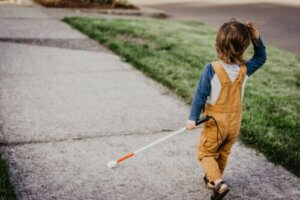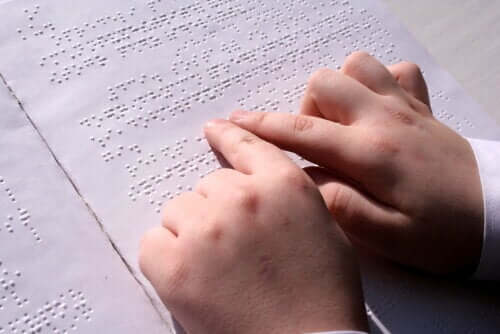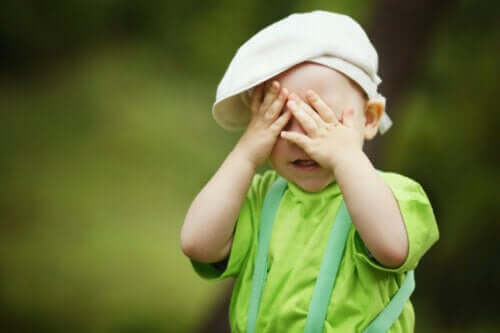Activities for Children with Visual Impairment

Considering the complexity involved in working with children with specific needs, some activities for children with visual impairment, in this case, can be of great support. Below you’ll find play-based and fun activities that help the little ones to improve their growth and integral development.
Visual impairment
According to the WHO (World Health Organization), visual function is subdivided into four levels: normal vision, moderate visual impairment, severe visual impairment and blindness.
The loss of vision functionality limits people in performing daily activities independently. It also implies limitations in the access to and participation in their different living environments, such as school, work and leisure.
People with significant visual impairment use a tactile reading and writing system known as the Braille system. This system is based on raised dots and dashes that are interpreted with the fingertips. In order for children to use it, they must have good spatial orientation (up, down, right, left), and a well-trained sense of touch.
A loss of visual ability in infancy can have important consequences on children’s cognitive and social development. So first of all, it’s essential to have a specific diagnosis in order to know the degree and type of vision loss.
Secondly, it’s important for educators to have the necessary training and knowledge to adapt educational responses to the needs of visually impaired children.

Activities for children with visual impairment
Below, we’ll share different activities for children with visual impairment. The main goal is to help them develop their language, motor skills and spatial orientation, and their other senses: hearing, smell, taste and touch. The latter is fundamental in order to read and write in Braille, having a bearing on the development of fine motor skills.
“Touching nature”
This activity aims to get children into contact with nature, so they can experience and explore all of its elements. As a result, they exercise their sense of smell, hearing and touch, manipulating and recognizing textures, smells, sizes and temperatures.
With this activity, the little ones can enjoy and play with water, humidity, mud, moss, sand, asphalt, stones and various leaves. They can also identify different sounds and noises, from water, wind or animals.
“Great little chefs”
An alternative to this activity can be to change the elements of nature for those of the kitchen. So, instead of recognizing and manipulating elements of Mother Earth and touching nature, children can become great little chefs. They can play with flour, rice, various vegetables or coffee, and can let themselves be carried away by smells and the sense of touch.
They can even choose to recognize fruits and vegetables according to their smells and textures. Thus, it’s better to open, peel and cut them, in order to exercise the sense of taste. They also have a good time tasting sweet fruits and trying some vegetables that can be eaten raw.

Let’s talk about skills and professions
Not having correct vision of the world can hinder the development of language in children with visual impairment. Therefore, it’s necessary to work on activities that allow them to exercise their language skills. Thus, an interesting activity is through contact with wood, nails and screwdrivers. Children can associate skills or professions with their representative tools.
So, when playing with an onion and a tomato, with tape and gauze, or with watercolors and paintbrushes, children can talk about different professions and skills.
Children can express what they believe or know about what they’re doing, or what it means to be a cook, a nurse or a painter. They can also talk to each other about what they do or what their relatives do. Or even about what they would like to do when they grow up and why.
“Search and find” – another activity to do with children with visual impairment
Children with visual impairment aren’t fully capable of having a global, simultaneous and anticipatory perspective of their environment. Therefore, it’s important to stimulate their psychomotor abilities, so that they can improve their gross motor skills and spatial orientation.
A suitable activity or exercise can be to use a chair in order to exercise notions of distance and movement. So, we’ll place a chair at a distance of about one meter (3 ft) from a child. According to precise indications of their parents or educators, they’ll have to reach the chair and sit down.
You can give indications such as: take X number of steps, to your left or right, turn around, keep your head up.
Considering the complexity involved in working with children with specific needs, some activities for children with visual impairment, in this case, can be of great support. Below you’ll find play-based and fun activities that help the little ones to improve their growth and integral development.
Visual impairment
According to the WHO (World Health Organization), visual function is subdivided into four levels: normal vision, moderate visual impairment, severe visual impairment and blindness.
The loss of vision functionality limits people in performing daily activities independently. It also implies limitations in the access to and participation in their different living environments, such as school, work and leisure.
People with significant visual impairment use a tactile reading and writing system known as the Braille system. This system is based on raised dots and dashes that are interpreted with the fingertips. In order for children to use it, they must have good spatial orientation (up, down, right, left), and a well-trained sense of touch.
A loss of visual ability in infancy can have important consequences on children’s cognitive and social development. So first of all, it’s essential to have a specific diagnosis in order to know the degree and type of vision loss.
Secondly, it’s important for educators to have the necessary training and knowledge to adapt educational responses to the needs of visually impaired children.

Activities for children with visual impairment
Below, we’ll share different activities for children with visual impairment. The main goal is to help them develop their language, motor skills and spatial orientation, and their other senses: hearing, smell, taste and touch. The latter is fundamental in order to read and write in Braille, having a bearing on the development of fine motor skills.
“Touching nature”
This activity aims to get children into contact with nature, so they can experience and explore all of its elements. As a result, they exercise their sense of smell, hearing and touch, manipulating and recognizing textures, smells, sizes and temperatures.
With this activity, the little ones can enjoy and play with water, humidity, mud, moss, sand, asphalt, stones and various leaves. They can also identify different sounds and noises, from water, wind or animals.
“Great little chefs”
An alternative to this activity can be to change the elements of nature for those of the kitchen. So, instead of recognizing and manipulating elements of Mother Earth and touching nature, children can become great little chefs. They can play with flour, rice, various vegetables or coffee, and can let themselves be carried away by smells and the sense of touch.
They can even choose to recognize fruits and vegetables according to their smells and textures. Thus, it’s better to open, peel and cut them, in order to exercise the sense of taste. They also have a good time tasting sweet fruits and trying some vegetables that can be eaten raw.

Let’s talk about skills and professions
Not having correct vision of the world can hinder the development of language in children with visual impairment. Therefore, it’s necessary to work on activities that allow them to exercise their language skills. Thus, an interesting activity is through contact with wood, nails and screwdrivers. Children can associate skills or professions with their representative tools.
So, when playing with an onion and a tomato, with tape and gauze, or with watercolors and paintbrushes, children can talk about different professions and skills.
Children can express what they believe or know about what they’re doing, or what it means to be a cook, a nurse or a painter. They can also talk to each other about what they do or what their relatives do. Or even about what they would like to do when they grow up and why.
“Search and find” – another activity to do with children with visual impairment
Children with visual impairment aren’t fully capable of having a global, simultaneous and anticipatory perspective of their environment. Therefore, it’s important to stimulate their psychomotor abilities, so that they can improve their gross motor skills and spatial orientation.
A suitable activity or exercise can be to use a chair in order to exercise notions of distance and movement. So, we’ll place a chair at a distance of about one meter (3 ft) from a child. According to precise indications of their parents or educators, they’ll have to reach the chair and sit down.
You can give indications such as: take X number of steps, to your left or right, turn around, keep your head up.
All cited sources were thoroughly reviewed by our team to ensure their quality, reliability, currency, and validity. The bibliography of this article was considered reliable and of academic or scientific accuracy.
- Roselló Leyva, A., Baute Puerto, B., Ríos García, M., Rodríguez Masó, S., Quintero Busutil, M. y Lázaro Izquierdo, Y. (2013). Estimulación temprana en niños con baja visión. Revista Habanera de Ciencias Médicas, 12(4), 0-0. Recuperado de http://scielo.sld.cu/scielo.php?script=sci_arttext&pid=s1729-519×2013000400018
- García-Trevijano Patrón, C., Leonhardt Gallego, M., Oyarzábal Céspedes, B. y Vecilla Rodrigo, I. (2012). Construir juntos espacios de esperanza. Orientaciones para el profesional de atención temprana a niños con ceguera o deficiencia visual. Serie: Guías. ONCE. Recuperado de http://riberdis.cedd.net/bitstream/handle/11181/3411/Construir%20juntos%20espacios%20de%20esperanza.pdf?sequence=1&rd=003187936466348
- Datta, P. (2017). Autoconcepto y discapacidad visual: una revisión bibliográfica. Recuperado de http://www.repositoriocdpd.net:8080/bitstream/handle/123456789/1883/Art_DattaP_AutoconceptoydiscapacidadVisual_2015.pdf?sequence=1
- Martínez-Liébana, I. y Polo Chacón, D. (2004). Guía didáctica para la lectoescritura Braille. Madrid: Organización Nacional de Ciegos Españoles. Recuperado de http://bibliorepo.umce.cl/libros_electronicos/diferencial/edtv_30.pdf
This text is provided for informational purposes only and does not replace consultation with a professional. If in doubt, consult your specialist.








